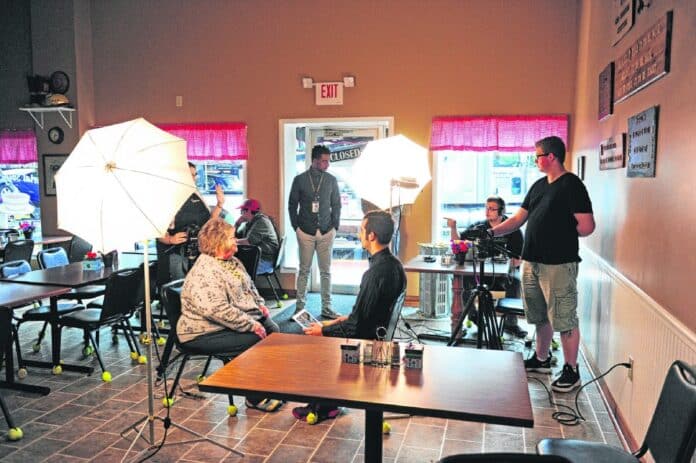
GREENFIELD — The studio lights cast a warm glow on Greenfield-Central High School sophomore LJ Rowlett and his interview guest at the Kenneth Butler Memorial Soup Kitchen.
Matt Kottlowski, a headphone-clad G-C senior, sat off to the side in front of a laptop and sound equipment. Fellow senior Abi McKinney manned a camera trained on Rowlett, while junior Preston Dyer aimed his at the person they were interviewing, Jill Ebbert, executive director of the soup kitchen.
A countdown commenced, and then the interview was under way.
[sc:text-divider text-divider-title=”Story continues below gallery” ]
Click here to purchase photos from this galleryOn its surface, the high school radio/TV class project gave students a chance to test the skills they’ve learned in a potential future career field. But it also taught them about nonprofit organizations right in their own back yard while creating exposure for those groups as well.
Jonathan Hudson, the high school’s radio/TV class teacher, said the soup kitchen was one of several nonprofit organizations that his students were featuring in their video projects.
Students took charge of the assignments from the first step of contacting the organizations to schedule times shoot, Hudson continued. They then researched the groups and developed interview questions.
“The kids have been fantastic,” Hudson said. “They’re very focused; they’re ready to go; they’re professional; they know what they’re doing. It makes it very easy.”
Hudson said he taught the students a “60 Minutes”-style interview technique using two cameras and positioning the interviewer across from the interviewee.
“In editing, it looks very personal,” he said. “It looks like a very intimate conversation.”
The project also requires students to recall lessons they’ve learned on lighting and recording sound that later gets synced with video using computer editing.
After the interview with Ebbert, she led the young production crew on a tour of the facility. Dyer filmed B-roll of the items discussed during the tour to be spliced throughout the shots of Rowlett walking and talking with Ebbert.
Hudson said so much of the project is driven by technology, something members of his students’ generation already understand.
“As far as it being a career choice, I think a lot of youth already have the skills in them just by growing up with technology,” he said. “It’s just a matter of focusing it in, fine-tuning it.”
Kottlowski plans on pursuing that kind of work for his career.
“I really want to get into telecommunications and making movies, and if high school can help me with that, then I should take something in high school to help me learn a little more about what I want to do,” he said.
The students’ videos on local nonprofit organizations will air on NineStar Connect’s Channel 9 this summer. Audio from the interviews will run on Greenfield-Central-based WRGF-FM (89.7), which Hudson also leads as general manager.
WRGF plays a role in the curriculum as well.
McKinney wants to work in the music industry after high school. She said the radio/TV class is teaching her how to use the equipment of the business, like the soundboard at WRGF.
She enjoys the collaborative nature of the class’s projects as well.
“It’s helping build my teamwork skills,” McKinney said.
Kottlowski said the class has helped teach him how to remain cool in stressful situations, like running the radio station’s board live on the air.
“You do not want to mess up,” he said.
Hudson said the video projects teach the students about more than camera angles, sound levels and video editing.
“This is their community and a lot of the students don’t know about these organizations,” he said. “I think it’s important that they learn about what’s in their community as well.”
Dyer agreed.
“It’s a good way to get out in the community, and Mr. Hudson does a great job of finding nonprofit organizations that we can spread the word about,” he said.
Dyer plans to study sports communication in college and become a sports broadcaster. He has been taking radio/TV classes at the high school for the past two years and intends to take one specifically on sports broadcasting next year.
There are about 70 to 80 students in the radio/TV program, spread across six classes, and one dedicated solely to sports, Hudson said.
Rowlett said heading out to shoot video and perfecting it in post production makes the course unlike others he’s taken.
“You get to have experiences that you’d never get to do in a normal class,” he said.




